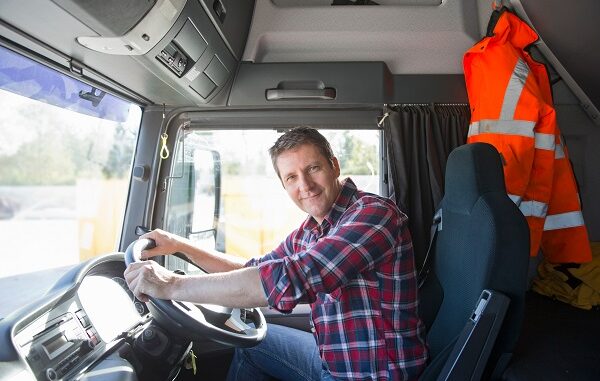
HGV drivers face a gauntlet of dangers on the road every day from dangerous drivers and insecure truck parks to fuel and cargo theft. That is often coupled with long journeys on motorways, traffic jams and tight delivery deadlines all within complex drivers’ hours regulations. Carol Millett looks at some of the latest technology that can keep them safe (first published in Transport News December 2024).
HGV drivers face endless hazards from dangerous drivers and insecure truck parks to fuel and cargo theft. That is often coupled with long journeys on motorways, traffic jams and tight delivery deadlines all within complex drivers’ hours regulations.
Fortunately, there is a host of ingenious technical developments to help keep truck drivers safe.

One example is a joint offering from worker security specialist Peoplesafe and fleet video and tracking experts Surecam. They’ve integrated the Peoplesafe Pro smartphone app with a range of SureCam dashcams in order to improve driver safety both inside and outside the cab.
Both are linked to a dedicated alarm receiving centre (ARC), which operates around the clock and provides a response so rapid that it is markedly faster than calling 999.
When an alarm is raised, ARC controllers can see both the app user’s details and a GPS view showing where the app and dashcam are located, as well as audio communication via the app, incident data and supporting dashcam footage leading up to the incident.
SureCam’s partnership director Sam Footer said: “We’re providing a solution that protects the driver both inside and outside of the cab. If there is a sharp braking incident or an overturned vehicle that sets our alarm off, we can instantly dial into that camera to see the driver is okay and call whichever emergency service is required; police, ambulance or fire brigade.
“And when the driver is outside the cab the Peoplesafe app can pick up whether a driver has, for example, fallen, and if there is no movement for a while it will raise the alarm. Drivers can also use a panic button in emergency situations.”
Mark Ryder is Peoplesafe’s chief commercial officer: “Home delivery is a large sector of ours and with the increase in theft, drivers being hijacked and attacked, and goods stolen from vehicles, there is a real need for lone-worker protection.”
Refuse collection truck manufacturer Dennis Eagle recently rolled out the solution across its 112-strong fleet of maintenance and breakdown response vehicles.
“Our main priority is the welfare of our service engineers when they are working remotely and at high-risk locations,” explained service operations manager Dave Nicholls.
“By bringing together our vehicle camera, tracking, driver behaviour and lone-worker protection requirements into an integrated technology solution, we can safeguard our team while achieving a host of secondary efficiency, productivity and cost improvements.”
Another major safety issue for HGV drivers is the poor security provided by many truck parks and motorway service stations. One solution recently launched in the UK by tech services giant Bosch Group is its Secure Truck Parking platform, which allows drivers to book into high-security parking spaces at truck stops.
It uses one central booking system across multiple platforms, updated in real time to ensure drivers are guaranteed a high-security parking spot, and informs the security team of arrival and departure times.
Widely used on the continent, Bosch’s first UK location, opened in April this year, is at the Red Lion truck stop in Northampton. More UK locations are planned in the near future.
Andrew Hayward is Bosch UK lead for Secure Truck Parking. He said too many drivers have to regularly choose between unsafe locations when deciding where to stop for the night, or even opt to sleep in a layby instead of a dedicated truck stop. “Cargo loss is a huge issue for hauliers, and with cargo theft on the rise it’s clear as an industry we need to work hard to find a better solution,” he said.
Fatigue is another professional hazard for HGV drivers faced with monotonous stretches of motorway, especially on night shifts when the body’s natural rhythms are geared for sleep.
To tackle this hazard, Bosch has developed a camera based system that can detect whether the driver’s full attention is on the road or if they are showing signs of drowsiness. If the driver appears tired, the system will prompt them to take a break.
It works by monitoring the driver’s steering behaviour throughout the journey and recognises changes that can indicate driver fatigue, such as times when the driver is barely steering, combined with slight, yet quick and abrupt steering movements to keep the car on track.
Based on the frequency of these movements and other parameters, including the length of the journey, use of turn signals and the time of day, the function calculates the driver’s level of fatigue. If that level exceeds a certain value, an icon flashes on the instrument panel to warn drivers that they need a rest.
It has evolved from a simple alert system for drivers on the road for two consecutive hours now monitors up to 70 signals, including key factors like steering inputs, time of day, and even the use of indicators, providing a more sophisticated assessment of driver alertness.
Some of the dangers drivers face can be self-inflicted, with fleet operators increasingly recognising the need to screen their drivers for drink and drugs.
One company providing the technology to do this is Alcolock UK. Its Alcolock V3 LE breathalyser uses the same alcohol-sensing technology used by police in roadside screening.
The in-cab device is connected directly to the vehicle’s ignition system. Before starting the engine, the driver blows into the handset, where an alcohol specific sensor analyses the breath sample and calculates the driver’s breath alcohol concentration (BrAC).
The ignition will only function if the BRaC sample provided is below the pre-set limit. Additional breath samples are required at random intervals during the journey to prevent other people providing the required breath sample.
Alcolock UK and its affiliates Alcolock France and Alcolock Sweden have seen growing demand from transport operators for the Alcolock V3 LE breathalyser over the past few years, explained Richard Thomas, Alcolock UK general manager.
“Transportation companies in the UK, Ireland and Europe are increasingly aware of the need to protect their employees and their businesses against corporate manslaughter charges, and to ensure that all employees who drive company vehicles are not able to drive after consuming alcohol,” he said.
“As a consequence of this initiative, companies have increased their orders of alcohol interlocks four-fold over the past 36 months.
“In general, transportation companies have recognised the safety merits of alcohol interlocks, and the economic value of installing these devices to prevent operation of vehicles by drivers who have been drinking.”
Bridge strikes are another hazard faced by HGV drivers. Network Rail calculates there were 5,029 of them across the national network between 1 April 2020 and 31 March 2023.
Many truck drivers appear blithely unaware of the risks, with 43% not knowing their vehicle height before heading out on the road and 52% not taking low bridges into account.
The consequences can be extremely costly. Aside from the risk of injury to themselves and others, most drivers involved in bridge strikes are prosecuted and, following conviction, can, on average, expect to receive five penalty points, fines amounting to around £600 and a possible suspension.
Drivers are also referred to the traffic commissioner as part of a driver conduct hearing and in many cases operators are also called to a public inquiry.
Network Rail is also entitled to recoup the entire cost of repairing a bridge strike and claim compensation for delayed trains from the operator.
 One solution from Parksafe Group is its Low Bridge Detection System, which takes the onus off drivers to identify possible bridge strikes. The system can detect up to 3,750 low bridges and requires no driver input.
One solution from Parksafe Group is its Low Bridge Detection System, which takes the onus off drivers to identify possible bridge strikes. The system can detect up to 3,750 low bridges and requires no driver input.
Using GPS vehicle location data, mapping services and a pre-defined database of low bridge hazards, the system sends real-time alerts to drivers when they approach a bridge that is too low, allowing them enough time to take an alternative route. Alerts are delivered audibly via speaker, and visibly via LED panels.
Liam Barber, Parksafe group sales and marketing director, said: “Drivers often do not know the height of the vehicle, which can lead to negligent behaviour and even the possibility of prosecution.
“Our Low Bridge Detection System does not rely on the driver at all, as the height of the vehicle is inputted at the point of installation. With no driver input necessary, they have added peace of mind and can focus on their driving.”
Monitoring drivers’ speed can also help keep them safe. Brigade’s recently launched Vehicle Telematics System goes well beyond the basic experience of being able to track a dot on a map, revealed James Tyrrell, Brigade’s fleet services technical support engineer.
The system includes unlimited geofencing, with the ability to set speed limits within a set geographic boundary, defined by GPS. A response is triggered when a device enters or leaves the area. Fleet managers can set their own geofences according to their areas of work.
He added: “Some companies, particularly those operating in remote areas with 4G such as mining operations, may have large off-road sites that don’t have a speed limit.
“Managers can set a speed limit up within the site’s geofence, and a notification will be sent if a vehicle exceeds that limit. The advantages to site safety are clear.”
The system also comes with towing detection, so a notification can be sent if a vehicle is moving without the ignition on or if other suspicious movement is detected, helping to prevent theft.




